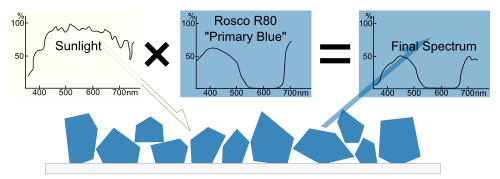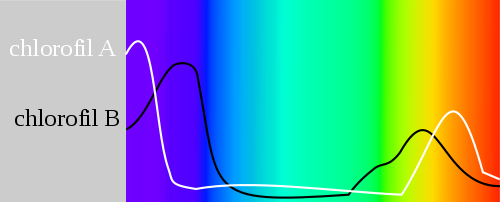TuckerD
Well-Known Member
Back to what I promised to write about earlier.
CRI only really applies to approximately white sources which doesn't include most LEDs. When you talk about an LED fixture in Lighting you are usually talking about a light with multiple colors of diode. In most cases that means RGB but some manufacturers use MYC and still others, like ETC, use ROYGCBI.
When we see colors on, say, a can of Mountain Dew we see a lot of green and white. That's because pigments (colors on stuff) absorb parts of the spectrum that are shined on them and reflect the part that we actually see. So a can of Mountain Dew illuminated by a source that emits all visible parts of the spectrum approximately equally what we see is only what is reflected back by the pigments (like green).
These images by Wikipedia contributor Phidauex should help explain this idea. I apologize for the transparent back ground.


So if we use a light source, like an LED fixture, that strictly emits the red, green, and blue parts of the spectrum some pigments are never reflected because they never receive the wavelength that they reflect. Imagine the first image above without the blue line, what would that look like? Well, with out blue light to reflect that pigment would actually appear to be "black".
Also notice that in the second image above that this is not a simple subtraction. It is actually a multiplication. This can be seen best if you look at the end of each spectragraph.
I am working on a project studying algae growth and remediation of co2 on the ISS. One of the things we need is seed algae for the project, in order to grow a lot of seed algae we build a bio farm using red and blue LEDs. The red led's we used are actually the same deep red LEDs that you would find in an ETC Selador fixture. Chlorofil (the green part of plants that is used for photosynthisis) reflects green light and absorbs red and blue light. The image below created by Wikipedia user Mix321 shows the absorption spectrum of chlorofil.

If you look at the algae cultures in our experiment while they are in the bio-farm they actually appear to be black because they are not illuminated with green light. If I had a good camera I would take some pictures that could show this. Maybe I can borrow a friend's.
The website I linked to earlier in the discussion called Steve's LEDs actually specializes in creating LED arrays for salt water aquariums which bring out the color of your coral and fish. The reason this works is because by increasing the amount of light that the pigments in your clown fish's scales reflect you can make your clown fish seem brighter and more vibrant.
ETC includes more LEDs in their Selador and LED fixtures because it increases the range of pigments that can reflect light. This is a good video to watch to see what I mean.
CRI only really applies to approximately white sources which doesn't include most LEDs. When you talk about an LED fixture in Lighting you are usually talking about a light with multiple colors of diode. In most cases that means RGB but some manufacturers use MYC and still others, like ETC, use ROYGCBI.
When we see colors on, say, a can of Mountain Dew we see a lot of green and white. That's because pigments (colors on stuff) absorb parts of the spectrum that are shined on them and reflect the part that we actually see. So a can of Mountain Dew illuminated by a source that emits all visible parts of the spectrum approximately equally what we see is only what is reflected back by the pigments (like green).
These images by Wikipedia contributor Phidauex should help explain this idea. I apologize for the transparent back ground.


So if we use a light source, like an LED fixture, that strictly emits the red, green, and blue parts of the spectrum some pigments are never reflected because they never receive the wavelength that they reflect. Imagine the first image above without the blue line, what would that look like? Well, with out blue light to reflect that pigment would actually appear to be "black".
Also notice that in the second image above that this is not a simple subtraction. It is actually a multiplication. This can be seen best if you look at the end of each spectragraph.
I am working on a project studying algae growth and remediation of co2 on the ISS. One of the things we need is seed algae for the project, in order to grow a lot of seed algae we build a bio farm using red and blue LEDs. The red led's we used are actually the same deep red LEDs that you would find in an ETC Selador fixture. Chlorofil (the green part of plants that is used for photosynthisis) reflects green light and absorbs red and blue light. The image below created by Wikipedia user Mix321 shows the absorption spectrum of chlorofil.

If you look at the algae cultures in our experiment while they are in the bio-farm they actually appear to be black because they are not illuminated with green light. If I had a good camera I would take some pictures that could show this. Maybe I can borrow a friend's.
The website I linked to earlier in the discussion called Steve's LEDs actually specializes in creating LED arrays for salt water aquariums which bring out the color of your coral and fish. The reason this works is because by increasing the amount of light that the pigments in your clown fish's scales reflect you can make your clown fish seem brighter and more vibrant.
ETC includes more LEDs in their Selador and LED fixtures because it increases the range of pigments that can reflect light. This is a good video to watch to see what I mean.


